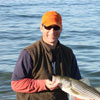Several Types of Fishing Maps to Help You on the Water
By Tom Keer
May 31, 2017
Once you're licensed and your boat is dewinterized you're ready to go fishing. A topographical fishing map or a nautical chart is an ideal way to find your spots and to navigate safely to them.
Your boat is ready, and so is your gear. Now it's time to go fishing, so pull out your fishing map and study the water. Lake maps, pond maps, and saltwater charts all reveal places to go fishing. How to fish them is part of the fun.
Nautical Charts for saltwater fishing are my favorite kind of fishing map. Nautical charts are a great way to learn about a new area, research a favorite stretch, see channels and markers, harbors, drop offs, flats, structure, and areas that run foul. The only downside to a printed fishing map is that they don't show changes that occurred during the winter. No power necessary, just keep 'em dry and match them up with a compass.
Freshwater topographical maps are great, too. Pond and lake maps show similar detail of drop offs, structure and areas that run foul, and they'll show inflows and outflows as well. Some topo maps are fishing focused, and they list public ramps, commonly caught fish species, favorite local lures, and hot places to fish. Some even include fishing techniques. All you need is tackle and a fishing license.
Electronic Chartplotters make for a perfect day on the water. Mount one on your console or use your phone. Charts can be easily updated, and if you travel to a new area then add new charts and roll. The ideal is to pair the chartplotter with a depth finder so you've got a total view of the fishing subject.
Google Earth makes for a great fishing map and is outstanding for entrance and exit points to put you as close to your fishing spot as possible. Google Earth is ideal for finding remote ponds or streams off the beaten path. Those ponds and streams might be a total bust. Or they might offer some of the best fishing of the year.
Nautical Charts for saltwater fishing are my favorite kind of fishing map. Nautical charts are a great way to learn about a new area, research a favorite stretch, see channels and markers, harbors, drop offs, flats, structure, and areas that run foul. The only downside to a printed fishing map is that they don't show changes that occurred during the winter. No power necessary, just keep 'em dry and match them up with a compass.
Freshwater topographical maps are great, too. Pond and lake maps show similar detail of drop offs, structure and areas that run foul, and they'll show inflows and outflows as well. Some topo maps are fishing focused, and they list public ramps, commonly caught fish species, favorite local lures, and hot places to fish. Some even include fishing techniques. All you need is tackle and a fishing license.
Electronic Chartplotters make for a perfect day on the water. Mount one on your console or use your phone. Charts can be easily updated, and if you travel to a new area then add new charts and roll. The ideal is to pair the chartplotter with a depth finder so you've got a total view of the fishing subject.
Google Earth makes for a great fishing map and is outstanding for entrance and exit points to put you as close to your fishing spot as possible. Google Earth is ideal for finding remote ponds or streams off the beaten path. Those ponds and streams might be a total bust. Or they might offer some of the best fishing of the year.
Popular Posts









